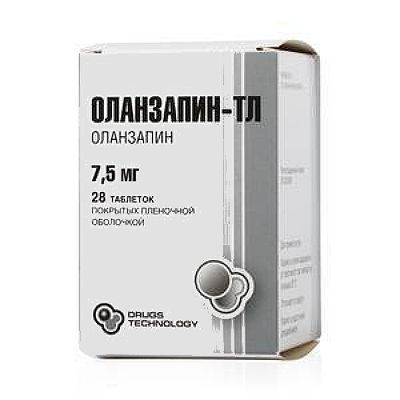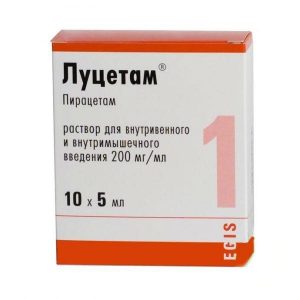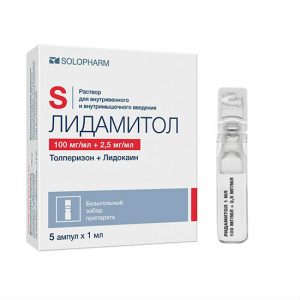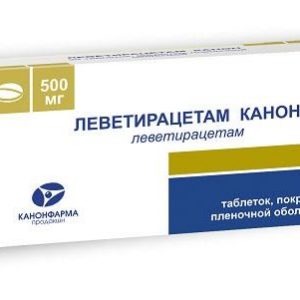Description
Pharmacological action of
Olanzapine is an antipsychotic (antipsychotic).
In preclinical studies, affinity for 5-HT2A / 2C, 5-HT3, 5-HT6-serotonin receptors, D1, D2-, D3-, D4-, D5-dopamine receptors, M-anticholinergic effects are due to blockade of M1-5- cholinergic receptors also have an affinity for 1-adreno- and H1-histamine receptors. In animal experiments, antagonism was revealed in relation to serotonin, dopamine and M-cholinergic receptors. In vivo and in vitro, olanzapine has a more pronounced affinity and activity for 5-HT2-serotonin receptors compared to D2-dopamine receptors. According to electrophysiological studies, olanzapine selectively reduces the excitability of mesolimbic dopaminergic neurons, and at the same time has an insignificant effect on the striatal neural pathways involved in the regulation of motor functions.
Indications
Schizophrenia. Bipolar affective disorder I type. Olanzapine in the form of monotherapy or in combination with lithium preparations or valproic acid is indicated for the treatment of acute manic or mixed episodes in bipolar affective disorder with / without psychotic manifestations and with / without rapid phase change. Olanzapine is indicated to prevent relapse in patients with bipolar disorder in whom olanzapine was effective in treating the manic phase. In combination with fluoxetine, olanzapine is indicated for the treatment of a depressive episode in the structure of bipolar disorder. Therapeutically resistant depression. In combination with fluoxetine, olanzapine is indicated for the treatment of therapeutically resistant depression in adult patients (major depressive episodes if history is present.
Contraindications
Hypersensitivity to any of the components of this drug. Hereditary galactose intolerance, lactase deficiency, glucose-galactose malabsorption. Contraindicated in persons under 18 years of age.
Special instructions
Suicide
The risk of a suicide attempt by patients with schizophrenia and bipolar disorder of the first type is due to the indicated diseases themselves. In this regard, against the background of pharmacotherapy, careful monitoring of those patients whose risk of suicide is particularly high is required. When prescribing olanzapine, one should strive to minimize the number of tablets taken by the patient in order to reduce the risk of overdose.
Hyperglycemia and diabetes
There is a higher prevalence of diabetes in patients with schizophrenia. As with some other antipsychotic drugs, there have rarely been cases of hyperglycemia, decompensation of diabetes mellitus, in some cases accompanied by ketoacidosis and diabetic coma, including death. Close clinical monitoring of patients with diabetes and patients with risk factors for diabetes is recommended.
Change in lipid concentration
Changes in plasma lipid concentration in the treatment with olanzapine should be monitored in patients with dyslipidemia and in patients with risk factors for impaired lipid metabolism.
M-anticholinergic activity of
In clinical trials, olanzapine therapy has rarely been accompanied by adverse reactions due to blockade of M-cholinergic receptors. However, clinical experience with olanzapine in patients with concomitant diseases is limited, so caution is advised when prescribing olanzapine to patients with clinically significant prostatic hyperplasia, paralytic ileus, angle-closure glaucoma, and similar conditions.
withdrawal syndrome With a sharp cessation of olanzapine, it is very rare (<0, 01%) the following symptoms may develop: sweating, insomnia, tremors, anxiety, nausea, or vomiting. Parkinson’s disease Olanzapine is not recommended for the treatment of psychosis induced by dopamine receptor agonists in Parkinson’s disease. In clinical studies in patients with psychosis induced by taking the drug (dopamine receptor agonist) in Parkinson’s disease, an increase in symptoms of Parkinsonism was noted very often ( 10%) and with a higher frequency than in the placebo group. Hallucinations were also observed very often ( 10%) and with a higher frequency than in the placebo group. Experience with elderly patients with dementia-related psychosis The efficacy of olanzapine in elderly patients with dementia-related psychosis has not been established. In this category of patients, in the placebo-controlled clinical trials, the mortality rate in the olanzapine group was higher than in the placebo group (3.5% versus 1.5%, respectively). Risk factors that may predispose this group of patients to higher mortality with olanzapine treatment include age> 80 years, sedation, combined use with benzodiazepineor the presence of lung pathology (e.g., pneumonia with or without aspiration). There is not enough data to establish differences in the incidence of cerebrovascular disorders and (or) mortality (compared with placebo) and in risk factors in this group of patients when taking olanzapine.
Impaired liver function
In some cases, taking olanzapine. As a rule, in the early stages of therapy, it was accompanied by a transient, asymptomatic increase in the activity of hepatic transaminases (ALT and ACT) in serum. Rare cases of hepatitis have been reported. In addition, there have been isolated reports of cholestatic and mixed liver damage. Particular caution is necessary when increasing the activity of ACT and (or) ALT in blood serum in patients with liver failure, with a limited functional reserve of the liver, with limited functional reserve of the liver or in patients receiving treatment with potentially hepatotoxic drugs. In case of increased activity of ACT and (or) ALT during treatment with olanzapine, careful monitoring of the patient is required and, if necessary, a dose reduction. In severe liver dysfunction caused by taking olanzapine, its use should be discontinued.
Neutropenia
Caution is advised to use olanzapine in patients with a low white blood cell and / or neutrophil count who are receiving drugs that can cause neutropenia with inhibition of bone marrow function due to concomitant disease, radiation or chemotherapy, as well as in patients with eosinophilia and (or ) myeloproliferative diseases. The development of neutropenia has been reported mainly with a combination of olanzapine with valproate.
Malignant Neuroleptic Syndrome (ZNS)
ZNS is a potentially life-threatening condition associated with antipsychotic therapy (antipsychotics), including olanzapine. Clinical manifestations of ZNS include a significant increase in body temperature, muscle rigidity, status changes and autonomic disorders (unstable pulse or blood pressure, tachycardia, increased sweating, cardiac arrhythmias). Additional symptoms of central nervous system: increased activity of creatine phosphokinase (CPK), myoglobinuria (with rhabdomyolysis) and acute renal failure. Clinical manifestations of ZNS or a significant increase in body temperature for no apparent reason require the abolition of all antipsychotics, including olanzapine.
Seizure Syndrome
Olanzapine should be used with caution in patients with a history of seizures or the presence of factors that lower the seizure threshold. In these patients, convulsive seizures were rarely observed with olanzapine treatment.
Late dyskinesia
In comparative studies, treatment with olanzapine was significantly less likely to be accompanied by the development of dyskinesias requiring medical correction than the use of typical and other atypical antipsychotics. However, the risk of tardive dyskinesia with prolonged antipsychotic therapy should be considered. With the development of signs of tardive dyskinesia, dose adjustment of an antipsychotic is recommended. It should be borne in mind that when transferred to olanzapine, symptoms of tardive dyskinesia may develop due to the simultaneous cancellation of previous therapy. Over time, the intensity of this symptomatology may increase, moreover, these symptoms may develop after discontinuation of therapy.
Total CNS activity
Caution should be exercised while using other central agents and alcohol.
Evolution of the risk of sudden death
Clinical experience with any antipsychotic, including olanzapine, has revealed a similar, dose-dependent, twofold increase in the risk of death due to acute heart failure compared with deaths due to acute heart failure in patients not using antipsychotics.
Cerebrovascular adverse events, including stroke in elderly patients with dementia
Cerebrovascular adverse events (eg, stroke, transient ischemic attack), including deaths, have been reported in studies of olanzapine in elderly patients with psychosis associated with dementia. Placebo-controlled studies showed a higher incidence of cerebrovascular adverse events in patients in the olanzapine group compared with the placebo group (1.3% versus 0.4%, respectively). All patients with cerebrovascular disorders had previous risk factors for the development of cerebrovascular adverse events (for example, the previously noted case of cerebrovascular adverse event or transient ischemic attack, arterial hypertension, smoking), as well as concomitant diseases and / or medication associated with cerebrovascular unwanted time phenomena. Olanzapine is not indicated for the treatment of patients with dementia-related psychosis.
QT interval
In clinical trials, a clinically significant lengthening of the QT interval (QT interval with Friedericia correction [QTcF]> 500 ms in patients with baseline, QTcF <500 ms) in patients receiving olanzapine was not observed, in the absence of significant differences with placebo by the frequency of occurrence of adverse events from the heart. However, as with other antipsychotic drugs, caution is advised when using olanzapine in combination with drugs that can extend the QT interval, especially in elderly patients, with congenital lengthening of the QT interval, chronic heart failure, myocardial hypertrophy, hypokalemia and hypomagnesemia . Thromboembolism When taking olanzapine very rarely (<0, 01%) reported cases of development of venous thromboembolism. A causal relationship between olanzapine therapy and thrombosis has not been established. Since patients with schizophrenia often have acquired risk factors for venous thrombosis, all other possible factors (for example, immobilization) should be identified and preventive measures taken. Blockade of dopamine receptors In vitro, olanzapine antagonizes dopamine receptors and, like other antipsychotics (antipsychotics), can theoretically suppress the effects of levodopa and dopamine receptor agonists. Postural hypotension Postural hypotension has been infrequently observed in clinical studies of olanzapine in the elderly. As with other antipsychotic drugs, in the case of the use of olanzapine, patients over 65 years of age are recommended to periodically monitor blood pressure. Children and adolescents under 18 Olanzapine is not recommended for use in children and adolescents under 18 due to the lack of sufficient data on efficacy and safety. In short-term studies conducted in adolescents 13-17 years old, a more significant increase in body weight and a change in the concentration of lipids and prolactin were noted than in similar studies in adults. Impact on the ability to drive transp. Wed and fur .: During the treatment period, care should be taken to engage in activities related to the need for concentration and high speed of psychomotor reactions. Composition 1 film-coated tablet contains: core: active substance: olanzapine 7.5 mg excipients: lactose monohydrate 190.5 mg, microcrystalline cellulose 75.0 mg, copovidone 12.0 mg, sodium carboxymethyl starch 12 , 0 mg, calcium stearate 3.0 mg film composition: opadry II (yellow) [polyvinyl alcohol 40% titanium dioxide 23.7% macrogol 20.2% talc 14.8% iron dye yellow oxide 1.3%] 9.0 mg Dosage and administration Inside, regardless of food intake, 1 time per day. Schizophrenia The recommended starting dose of olanzapine is 10 mg once daily. The therapeutic doses of olanzapine range from 5 mg to 20 mg per day. The daily dose must be selected individually depending on the clinical condition of the patient. Increasing the dose above the standard daily dose (10 mg) is recommended only after assessing the clinical picture. When using the drug, it is necessary to regularly evaluate the need for continued therapy. Bipolar Disorder For the treatment of a manic episode, the recommended starting dose of olanzapine is 15 mg once daily as monotherapy or 10 mg once daily in combination with lithium or valproic acid. The therapeutic doses of olanzapine range from 5 mg to 20 mg per day. The daily dose must be selected individually, depending on the clinical condition of the patient. Increasing the dose above the standard daily is recommended only after assessing the clinical picture and with an interval of at least 24 hours. Maintenance therapy for bipolar disorder: patients taking olanzapine for the treatment of a manic episode, it is necessary to continue maintenance therapy in the same dose. In patients in remissionthe recommended initial dose of olanzapine is 10 mg once a day. In the future, the daily dose must be selected individually depending on the clinical condition of the patient, in the range from 5 mg to 20 mg per day. To treat a depressive episode, olanzapine should be prescribed in combination with fluoxetine once a day, in the evening, regardless of food intake. As a rule, the initial dose is 5 mg of olanzapine and 20 mg of fluoxetine. Antidepressant activity was confirmed with the use of olanzapine at a dose of 6-12 mg (average daily dose – 7.4 mg) and fluoxetine at a dose of 25-30 mg (average daily dose – 39.3). If necessary, a change in the dose of both olanzapine and fluoxetine is allowed. When using the drug, it is necessary to regularly evaluate the need for continued therapy. Therapeutically resistant depression Olanzapine should be given in combination with fluoxetine once a day, in the evening, regardless of food intake. As a rule, the initial dose is 5 mg of olanzapine and 20 mg of fluoxetine. If necessary, a change in the dose of both olanzapine and fluoxetine is allowed. Antidepressant activity is confirmed with the use of olanzapine at a dose of 6-12 mg and fluoxetine at a dose of 25-30 mg. When using the drug, it is necessary to regularly evaluate the need for continued therapy. General oral dosage regimen for specific patient groups Initial dose reductions of up to 5 mg per day are recommended for elderly patients or patients with other clinical risk factors, including severe renal failure or moderate liver failure. Initial dose reduction may be recommended for patients with a combination of factors (female, senile, non-smokers) who can slow down the metabolism of olanzapine. The use of olanzapine has not been studied in individuals under 13 years of age. Side effects Frequency of side effects: very often (more than 10%), often (more than 1% and less than 10%), not often (more than 0.1% and less than 1%), rarely (more than 0.01% and less than 0.1%), very rarely (less than 0.01%). From the nervous system: very often – drowsiness often – dizziness, akathisia, parkinsonism, asthenia, dyskinesia rarely – seizures in patients with a history of seizures or in the presence of risk factors for seizures very rarely – malignant antipsychotic syndrome (see Special instructions) , dystonia (including oculogyric crisis) and tardive dyskinesia. With the abrupt withdrawal of olanzapine, symptoms such as excessive sweating, insomnia, tremor, anxiety, nausea, or vomiting are very rare. From the cardiovascular system: often – arterial hypotension (including orthostatic) not often – bradycardia with or without collapse very rarely – increased QTc interval on the ECG (see Special instructions), ventricular tachycardia / fibrillation and sudden death ( see the Special Instructions section) very rarely – thromboembolism (including pulmonary embolism and deep vein thrombosis). From the digestive system: often – transient anticholinergic effects, including constipation and dryness of the oral mucosa, transient asymptomatic increase in the activity of hepatic transaminases (ALT, ACT, especially at the beginning of therapy (see the Special Instructions section)) rarely – hepatitis (including hepatocellular, cholestatic or mixed liver damage) very rarely – pancreatitis. From the side of metabolism: very often – weight gain often – increased appetite, hypertriglyceridemia very rarely – hyperglycemia and / or decompensation of diabetes, sometimes manifested by ketoacidosis or coma, including fatal hypercholesterolemia, hypothermia. From the hemopoietic system: often – eosinophilia rarely – leukopenia very rarely – thrombocytopenia, neutropenia. From the musculoskeletal system: very rarely – rhabdomyolysis. From the genitourinary system: very rarely – urinary retention, priapism. From the skin: rarely – skin rash is infrequent – photosensitization reactions are very rare – alopecia. From the endocrine system: an increase in prolactin content (clinical manifestations of hyperprolactinemia were rare, in most cases, prolactin levels normalized without canceling olanzapine) in rare cases – hyperglycemia, diabetic coma, diabetic ketoacidosis. Allergic reactions: rare – skin rash very rarely – anaphylactoid reactions, angioedema, pruritus or urticaria. From the hemopoietic system: often – eosinophilia rarely – leukopenia very rarely – thrombocytopenia. Other: often – asthenia, peripheral edema is very rare – withdrawal syndrome. Laboratory indicators: very often – hyperprolactinemia, but clinical manifestations (e.g. gynecomastia, galactorrhea and breast enlargement) – rarely. In most patients, prolactin levels spontaneously returned to normal without discontinuing therapy. Rarely – transient, asymptomatic increase in ALT activity, ACT. Infrequently – an increase in the activity of creatine phosphokinase (CPK) is very rare – an increase in the activity of alkaline phosphatase (ALP) and total bilirubin. In isolated cases, an increase in plasma glucose of more than 200 mg / dl (suspected diabetes mellitus), 160-200 mg / dl (suspected hyperglycemia) in patients with an initial glucose concentration of less than 140 mg / dl. There were cases of an increase in triglycerides (by 20 mg / dl from the initial), cholesterol (by 0.4 mg / dl from the initial), asymptomatic eosinophilia (isolated cases). In elderly patients with dementia, a high frequency of deaths and cerebrovascular disorders (stroke, transient ischemic attacks). Very frequent in this category of patients were gait and fall disorders. Pneumonia, fever, lethargy, erythema, visual hallucinations, and urinary incontinence were also frequently observed. Among patients with drug (while taking dopamine agonists) psychoses during Parkinson’s disease, worsening Parkinsonian symptoms and the development of hallucinations were often recorded. There is evidence of the development of neutropenia (4.1%) in combination therapy with valproic acid in patients with bipolar mania. Simultaneous therapy with valproic acid or lithium increases the frequency (more than 10%) of tremor, dry oral mucosa, increased appetite, or increased body weight. Speech disorders were also recorded (from 1 to 10%). Overdose Symptoms: very frequent (over 10%) in case of an overdose of olanzapine are tachycardia, agitation / aggression, dysarthria, various extrapyramidal symptoms, a decrease in the level of consciousness from lethargy to coma in less than 2% of cases – delirium, convulsions. Coma, malignant antipsychotic syndrome, respiratory depression, aspiration, arterial hypertension or arterial hypotension, arrhythmias in very rare cases – cardiopulmonary failure. The minimum dose for an acute overdose with a fatal outcome is 450 mg, the maximum dose for an overdose with a favorable outcome (survival) is 1,500 mg. Treatment: There is no specific antidote. It is not recommended to provoke vomiting. It is necessary to carry out: gastric lavage, intake of activated carbon (reduces the bioavailability of olanzapine by 60%), symptomatic treatment under the control of vital functions, including treatment of arterial hypotension and collapse, maintenance of respiratory function. The use of epinephrine, dopamine or other sympathomimetics with beta-adrenomimetic activity is not recommended, because the latter may exacerbate arterial hypotension. To identify possible arrhythmias, monitoring of cardiovascular activity is necessary. The patient should be under continuous medical supervision until complete recovery. Storage conditions In a dry, dark place at a temperature of no higher than 25 ° C. Keep out of the reach of children. Expiration 2 years. Do not use after expiration date. Conditions of dispatch from pharmacies d46 Terms and conditions Formulation tablets




